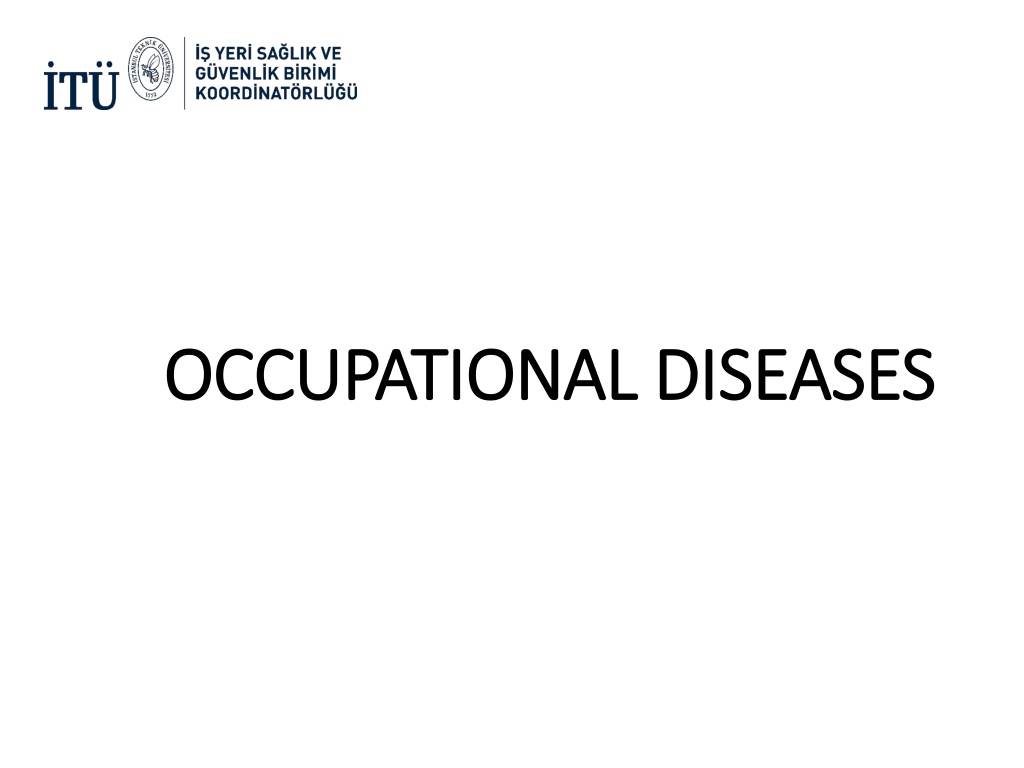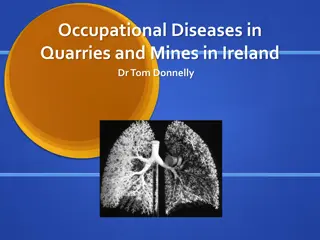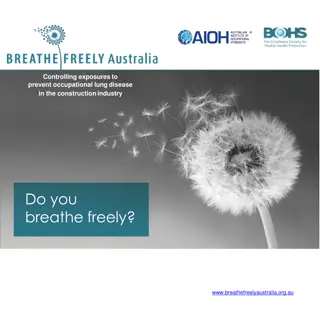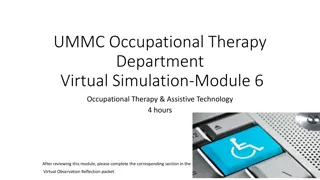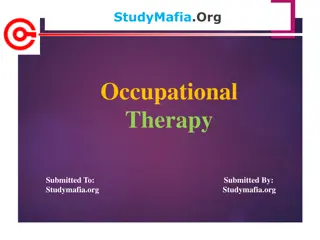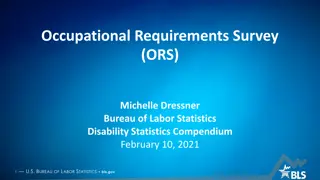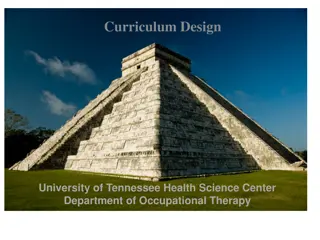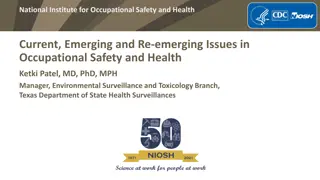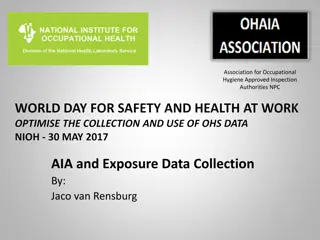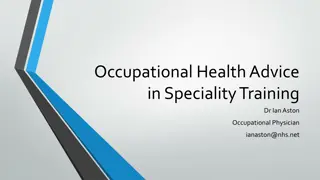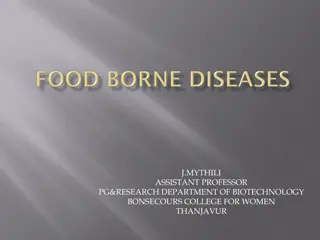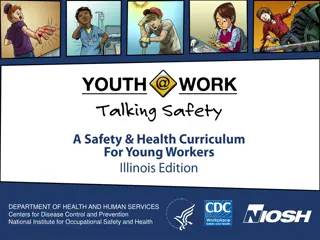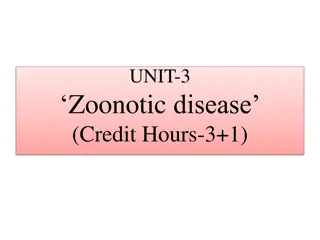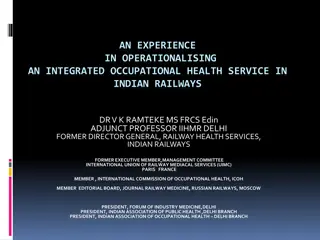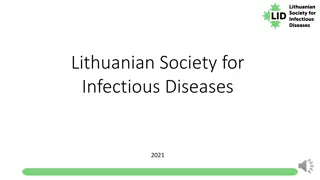Understanding Occupational Diseases and Prevention Methods
This detailed training covers basic concepts of occupational diseases, types, diagnostic methods, protection measures, statistics, and legal procedures. It emphasizes the preventable nature of occupational diseases and the importance of legal responsibilities. The visuals and statistics presented highlight the global impact of occupational diseases and focus on the significance of work-related health issues.
Download Presentation

Please find below an Image/Link to download the presentation.
The content on the website is provided AS IS for your information and personal use only. It may not be sold, licensed, or shared on other websites without obtaining consent from the author. Download presentation by click this link. If you encounter any issues during the download, it is possible that the publisher has removed the file from their server.
E N D
Presentation Transcript
OCCUPATIONAL DISEASES OCCUPATIONAL DISEASES
LEARNING OBJECTIVES At the end of the training; Basic concepts of occupational diseases Types of occupational diseases and diagnostic methods Methods of protection from occupational diseases Occupational diseases statistics Legal procedures Learns legal responsibilities.
DNYADA DURUM EVERY YEAR According to WHO (2005) 2.2 million employees die from Occupational Disease or Occupational Accident. 4-12 of every 1000 employees get Occupational Disease.
%1 %44 %56 OD AW %99 WORLD TURKEY OCCUPATIONAL DISEASES - ACCIDENTS AT WORK
DISEASES 1- General health problems- Most often 2- Work-related diseases- in the second frequency 3- Occupational accidents and occupational diseases- in the third frequency They are seen. Occupational diseases are preventable diseases specific to working life.
Emerging cases of occupational diseases / 100000 (WHO-2009) EU TR Kaynak: WHO/Europe, European HFA Database, January 2009
OCCUPATIONAL DISEASE According to the 14th article of 5510 Social Insurance and General Health Insurance Law; It is a temporary or permanent illness, disability or mental malfunction that the insured suffers due to the recurring reason or the execution conditions of the job, depending on the nature of the job. May occur between 1 week and 30 years after the first contact of the employee with the agent. The disease that is common during working in a certain profession and which can be experimentally created under the same conditions is occupational disease.
OCCUPATIONAL DISEASES OCCUPATIONAL DISEASES; It occurs with factors encountered in working life. It is specific to the profession. There is a causality (cause-effect) relationship between illness and work. It has a chronic course. It occurs as a result of being affected by a repeated cause. The incidence is high among those working in the same profession. It can be created experimentally.
WORK-RELATED DISEASE Apart from known and accepted occupational diseases, in their emergence and development; Working environment, How it works, and Diseases caused by other factors. There is no cause / effect relationship.
EXPOSURE AND OBLIGATION TIME EXPOSURE AND OBLIGATION TIME EXPOSURE TIME The minimum time required for symptoms to appear with the onset of contact with the harmful agent. At least two years in noisy work in order to be considered noise damages professional, The noise intensity must have worked for at least 30 days in jobs above 85 dB. OBLIGATION PERIOD The longest acceptable time between the end of the harmful occupational effect and the emergence of the disease. Example: 40 years of working with asbestos
OCCUPATIONAL DISEASE CRITERIA The most important feature that distinguishes occupational diseases from other diseases is that they originate from production . According to this; a) The employee is from SGK, b) It is a job that the worker is obliged to do, c) The emergence of a disease resulting from the work of the worker, d) This disease is a recurrent (chronic) disease, e) The worker must be in a state of permanent illness, disability or physical / mental loss of health.
CHARACTERISTICS OF OCCUPATIONAL DISEASES Occupational diseases can occur between 1 week and 30 years. In the occurrence of occupational diseases, the disease may have started and even disability occurred before the complaints appeared many times. Occupational disease often stops at that stage if the worker is disengaged from the factor causing the occupational disease. Occupational disease can also occur in the form of disability or mental problems. In order to diagnose occupational diseases, specialist organizations are needed.
CLASSIFICATION REASONS OF OCCUPATIONAL DISEASES 1) Chemically sourced 2) Physical origin 3) Biologically sourced 4) Psychosocial origin 5) It may occur for ergonomic reasons.
According to the Health Transactions Regulation, OCCUPATIONAL DISEASES are divided into 5 main groups: 1- (Group A) Occupational diseases caused by chemicals; 2- (Group B) Occupational skin diseases; 3- (Group C) Pneumoconiosis and other diseases of the respiratory system; Respiratory system diseases such as silicosis, asbestosis, occupational asthma, bisinosis
4- (Group D) Occupational infectious diseases; 5- (Group E) Occupational diseases caused by physical factors
CHEMICAL FACTORS Today, over 80 thousand chemicals are used in the industry. Toxic (toxic) can cause different harmful effects, immediately or after years. Toxic chemicals can also have local and systematic effects depending on the type of chemical substance and the route of exposure to the substance. 78479
INTRODUCTION WAYS OF CHEMICALS IN BODY 1-Through inhalation 2-Through Digestion 3-Absorption (by skin or eyes) danger
EFFECTS OF CHEMICAL SUBSTANCES ON HUMAN HEALTH Physical form of the substance SOLIDS 1- The substance with the lowest probability of causing chemical poisoning is solid. However, some of the solid chemicals can cause poisoning when it gets on the skin or food. 2- Chemicals in solid form may produce toxic vapors that can be inhaled, be flammable and flammable or damage the skin. mineral
EFFECTS OF CHEMICAL SUBSTANCES ON HUMAN HEALTH Physical form of the substance SOLIDS Mines have been an important cause of occupational diseases for centuries. Although innovations in technology eliminate some of the MH caused by mines, mines are still an important source of MH. Dust and vapor of mines enter the human body mainly through breathing. The toxic effect of iron and aluminum, which is widely used in industry and requires high temperature during use, is less than other mines. On the other hand, lead, mercury, copper, beryllium, chromium, nickel, arsenic, cobalt, cadmium and thallium are among the hazardous minerals in terms of worker health.
EFFECTS OF CHEMICAL SUBSTANCES ON HUMAN HEALTH Physical form of the substance LIQUIDS Most of the hazardous substances such as acids and solvents are liquid at normal temperature. Many liquid chemicals emit vapors that can be inhaled and can be very toxic depending on the type of chemical substance. Liquid chemicals can be absorbed through the skin. kimya_kobi_2
SOLVENTS 1. 2. 3. Benzene (Causes leukemia) Benzene homologs (Toluol, xylol, strien) Substances obtained from oil; (They can cause gasoline, diesel oil, fuel oil folliculitis and skin cancer.) Trchlorethylene Nerve degeneration, sudden cardiac arrest) Carbon tetrachloride (Liver and kidney damage, cirrhosis) Tetraklor ethane (Nervous system disorders, coma and death) 4. 5. 6.
ALCOHOLS (Methyl alcohol causes blindness, butanol defects cornea.) KETONES (Nail polish remover; headache, dizziness, eye and respiratory irritation) ESTERS (Dimethyl sulfate; causes lung edema) GLYCOLS (Eye, nose irritation, personality disorder) ETHERS (Eye, skin, left. Irritation, bronchopneumonia, lung. edema) CARBON SULFUR(Mental blur, coma)
TOXIC GASES Carbon monoxide Sulphurous hydrogen Halogens (Chlorine, Bromine, Iodine, Fluor) Ammonia Sulfur dioxide Nitrous gases (oxides of nitrogen gas) Nitrogen dioxide Phosgene Cyan gas
OCCUPATIONAL SKIN DISEASES Occupational skin cancers (Chimney cleaning, tar exposure, meat-fish smoking) Non-occupational cancer skin diseases Inflammation and peeling, rashes on the skin in days or years. Chronic exposure to irritants, allergens, solvents, and detergents may eventually occur. (Strong acids, alkalis, detergents.)
PHYSICAL RESOURCE OCCUPATIONAL DISEASES Noise and jerky works, Working in hot or cold environment, Working at low or high pressure, Radiation (ionized and non-ionic), (Construction business lines, factories and workshops, mining, shipyards, stone and sand quarries, textile, radiology units )
NOISE It can be defined as unpleasant, unwanted, disturbing sound. Among the environmental factors encountered in industry, noise is the most common factor after temperature. Defined as unwanted and unpleasant sound, noise occurs during the execution of many jobs. The health effect of the noise is due to the severity of the sound that occurs. Sound is a physical phenomenon.
THE EFFECTS OF NOISE ON HUMAN HEALTH Psychological effects: Nervous impairment, fear, fatigue, anxiety, insomnia Physiological effects: Hearing loss or slipping of the hearing threshold, ear pain, nausea, increased blood pressure, As communication with speech is impaired, work efficiency decreases and it poses a risk in terms of job security.
Noise-related hearing loss and features of professional deafness - Their intensity occurs at sounds above 85 dB (A), - Hearing loss is usually bilateral, except for very specific jobs. it is at the same level in the ear. The first hearing loss is that our ear hears a frequency of 4000 Hz. occurs in the section. It then begins to affect speech frequencies. - Since hearing loss is a neural type loss, it does not improve, so noise protection is extremely important.
MOSTURE It should be ensured that the humidity in the working environment is at the proper level. Moisture should be reduced as the temperature increases.
RAY's Ionizing radiation X rays Gamma rays Non-ionizing radiation Radio waves Micro waves Infrared rays Laser Ultraviolet
VIBRATION It is a fact that causes damage to employees. It is seen in vibrating areas or in workers working with vibrating hand tools. It damages the nervous, bone, digestive system, veins, wrist, elbow and shoulders. It causes white finger disease.
POWDERS POWDER; It is the general name for air suspended particles with a particle size of less than 100 microns. Chemical Structure of Powders: Powders are divided into two basic groups according to their chemical structure. Powders of inorganic structure: like iron, coal Organic structure powders: Such as wood dust, cotton dust
POWDERS When inhaled, dust particles larger than 10 microns are usually captured by the hair and mucous in the nose, and the body expels them. However, particles smaller than 5 microns are more dangerous. Because they reach the extremes (alveoli) of the lungs. Or it can get into the blood and cause destruction in other parts of the body. Dust particles can also affect and damage the eyes. Some dusts (in grain silos or flour mills) may explode.
OCCUPATIONAL LUNG DUST DISEASES Pneumoconiosis: It is a disease caused by the accumulation of dust in the lung and tissue reaction due to them. Silicosis SIDEROS Berilyosiz byssinosis Bagozosis
SILICOSIS Active; free silica powder (SiO2) 0.5-5 micron size powders Opening galleries in mines, road, railway, dam construction, tunnel excavation works those working in crushing and grinding raw materials in the ceramic and glass industry, working in firebrick making, furnace repair
BYSSNOSS Cotton, flax, hemp powders 5-6 years exposure ASBESTOS S : It is formed with asbestos powders.
OCCUPATIONAL INFECTIOUS DISEASES bacteria viruses Mushrooms parasites Business lines: kovid-19 infection for all healthcare workers, lab. employees, those engaged in agriculture and animal husbandry, veterinarians bakteri1
NEW HOST INFECTION CHAIN
FROM OCCUPATIONAL DISEASES PROTECTION WHAT IS PROTECTION? To prevent the emergence of occupational diseases in employees who do not have a known disease; identification of hazards defining, It is changed.
PROTECTION METHODS 1-Source protection 2- Environment Protection 3-Protection of the Person
TECHNICAL PROTECTION 1.The ambient atmosphere of the workplace should be kept under constant control and supervision and necessary measurements and improvements should be made. 2.Engineering measures are at the forefront in the works to be carried out at its source. 3.After taking these precautions, personal protector should be used.
MEDICAL PROTECTION 1- Recruitment medical examinations 2- Periodic inspections 3- Education and Stimulation 4- Operating at short intervals 5- Rotational operation
PERSONAL PROTECTION 1- Respiratory Protection 2- Eye Protection 3- Skin Protection 4- Protection of the Head 5- Foot Protection 6- Face Protection 7- Immunization
OCCUPATIONAL DISEASES WITH RESPECT TO THE DIAGNOSIS PROCESS IN TURKEY OCCUPATIONAL DISEASES WITH RESPECT TO THE DIAGNOSIS PROCESS IN TURKEY SGK YSK State Hospitals Workplace Physician Profession Hst. hospitals Labor and SSI Regional Manager. WORKPLACE E itim- Ar .hst. Medical Faculties WORKER Labor courts Business Inspection ISGUM Unions etc..
TREATMENT OF OCCUPATIONAL DISEASES Stop exposure Specific treatment, if any Rehabilitation procedures
OBLIGATIONS OF THE EMPLOYER IN M.H. The employer must take all kinds of health measures at the workplace. It is imperative that the worker has a medical report and an employee file before starting work. Starting from the day the occupational disease is learned, it must be reported to the Authority within three working days. Otherwise, all costs incurred by the institution are recoursed to the employer.
OBLIGATIONS OF THE WORKER IN M.H. The employee is obliged to notify the employer of the situation from the day he notices. The employee must accept the treatment and follow the advice. If he does not accept treatment, no health benefits will be provided, and the incapacity benefit will not be paid. He can start his job again by getting a certificate from the physician he is under treatment about that the treatment has ended and is operable.
LAST WORD Whether you are less or less injured; It should never be forgotten that occupational diseases are "preventable". To be prevented depends on "intention". The intention is determined by law, and concluded by practices. This intent is undoubtedly related to the respect of the worker, employer and the state for human rights.
